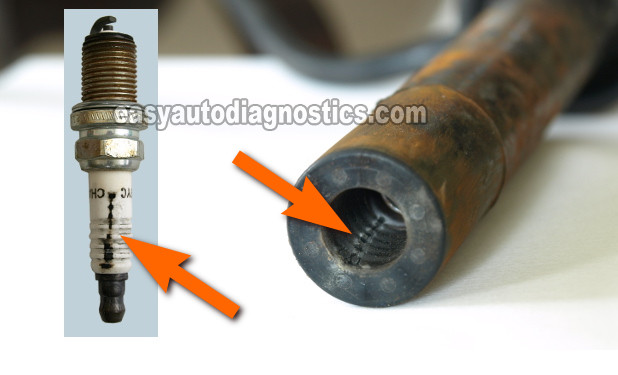TEST 7: Switching Signal For Cylinders 2 And 3

In this test step, you'll be verifying that the PCM is creating and feeding the Switching signal (for cylinders 2 and 3) with an LED Light.
This test will de done with the ignition coil pack must be connected to its connector.
If you don't have an LED light, you can find out more about it and where to buy one here: The LED Light Test Tool And How To Make One.
This is what you need to do:
- 1
With an appropriate tool, connect the black lead of the LED light to the wire identified with the number 1 in the image viewer.
This is the circuit that feeds the Switching signal to the ignition coil (within the coil pack) that feeds spark to cylinders 2 and 3 simultaneously. - 2
Connect the red lead of the LED light to the battery positive (+) terminal.
- 3
Have your helper crank the engine.
NOTE: The car may start so be careful. - 4
If the Switching signal is present, the LED light will flash ON and OFF the whole time the engine was cranking and during the time it was running.
Let's take a look at what your test results mean:
CASE 1: The LED light flashed ON and OFF the whole time the engine was cranking or running. This is the correct and expected test result and it tells you that the PCM is providing the Switching signal and the circuit is OK.
This result confirms that the ignition coil pack is bad and needs to be replaced only if you have:
- Confirmed that the spark plug wires for cylinder #2 and cylinder #3 are not sparking (TEST 1).
- Confirmed that the ignition coil towers for cylinder #2 and cylinder #3 are not sparking (TEST 4).
- Confirmed that the ignition coil's Switching signal is present in this test section.
CASE 2: The LED light DID NOT flash ON and OFF the whole time the engine was cranking or running. Without a Switching signal the ignition coil will not fire off spark to cylinder #2 and cylinder #3.
The most likely cause of this missing signal is either an open-circuit problem in the circuit between the connector and the PCM or the PCM is fried (altho' a fried PCM is rare). With this result you have eliminated the coil pack as the source of the misfire condition or no-spark condition.
Other Possible Misfire Causes

So you've done all of the spark tests, and still your Chrysler (or Dodge or Eagle or Plymouth) four banger is still misfiring. Well, here are a couple of suggestions that might help:
- Inspect the inside of the spark plug wire boots and remove the spark plugs to visually check their ceramic insulators for carbon tracks
- The photo above points (the orange arrows) to what carbon tracks look like.
- Replace the components as affected with carbon tracks.
- Inspect the inside of all of the spark plug tubes. It's possible that the valve cover spark plug tube seals are leaking engine oil into the spark plug tubes.
- If engine oil is filling up the tubes, you'll need to replace the valve cover gasket along with the spark plug tube seals, the spark plugs, and the spark plug wires.
- Engine compression test.
- This is one of the easiest, yet most overlooked test to find the cause of a misfire condition.
- You'll need an engine compression tester of course.
- The engine compression value recorded on the compression gauge (between cylinders) should not vary more 15%.
- You can find a step-by-step compression test article here: How To Test The Engine Compression (Chrysler 2.0L, 2.4L) (at troubleshootmyvehicle.com).
- Fuel injector test.
- There are several methods to test them which are beyond the scope of this article but the fastest way to test them is by checking the resistance (Ohms) value of each one with a multimeter and comparing the Ohms values to each other.
- Any resistance that's not within the average of the others indicates the fuel injector is fried. If the Ohms readings are nearly identical to each other, you can rule them out as the cause of the misfire.
- Or you can buy a specific fuel injector tester (on line) that activates the fuel injector by a predetermined pulse width in conjunction with a fuel pressure gauge that will show you the fuel pressure drop this tester will cause.
- The following tutorial will explain the fuel injector test: How To Test A Fuel Injector (Chrysler 2.0L, 2.4L) (at troubleshootmyvehicle.com).

If this info saved the day, buy me a beer!

